Financial Analysis and Strategic Management for BeaverBrook Jeweller
VerifiedAdded on 2021/02/19
|15
|5002
|152
Report
AI Summary
This report provides a comprehensive analysis of finance for strategic managers, using BeaverBrook the Jeweller, a small family business, as a case study. It explores the importance of financial information, the identification of business risks, and the use of financial data to make strategic business decisions. The report delves into the purpose, structure, and content of published accounts, including the interpretation of financial information and the calculation of key financial ratios. It also distinguishes between long and short-term financial requirements, examines cash flow management techniques, and evaluates methods for appraising strategic capital. The analysis covers various financial aspects, from income statements and balance sheets to ratio analysis and risk assessment, providing insights into financial health and strategic planning.
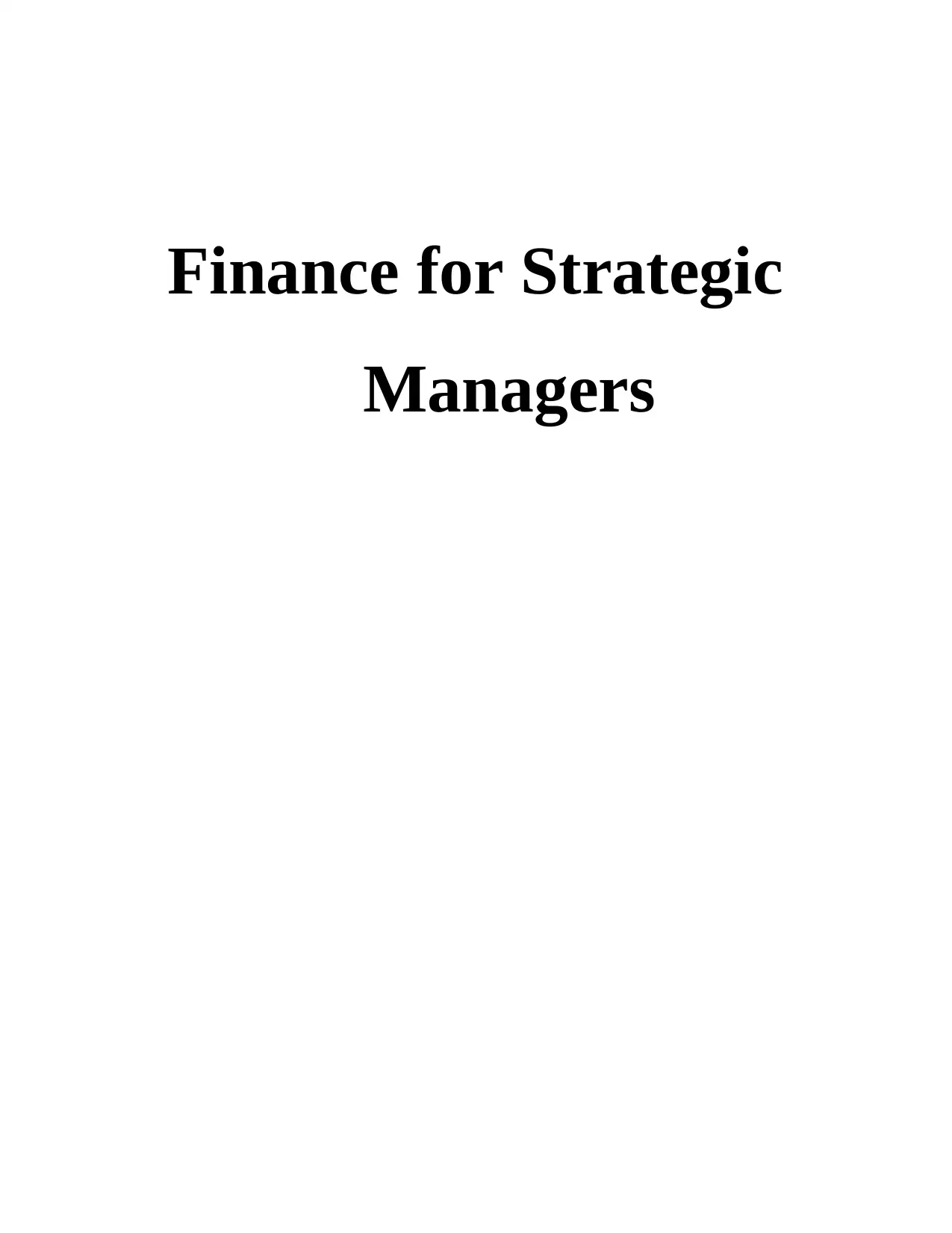
Finance for Strategic
Managers
Managers
Paraphrase This Document
Need a fresh take? Get an instant paraphrase of this document with our AI Paraphraser

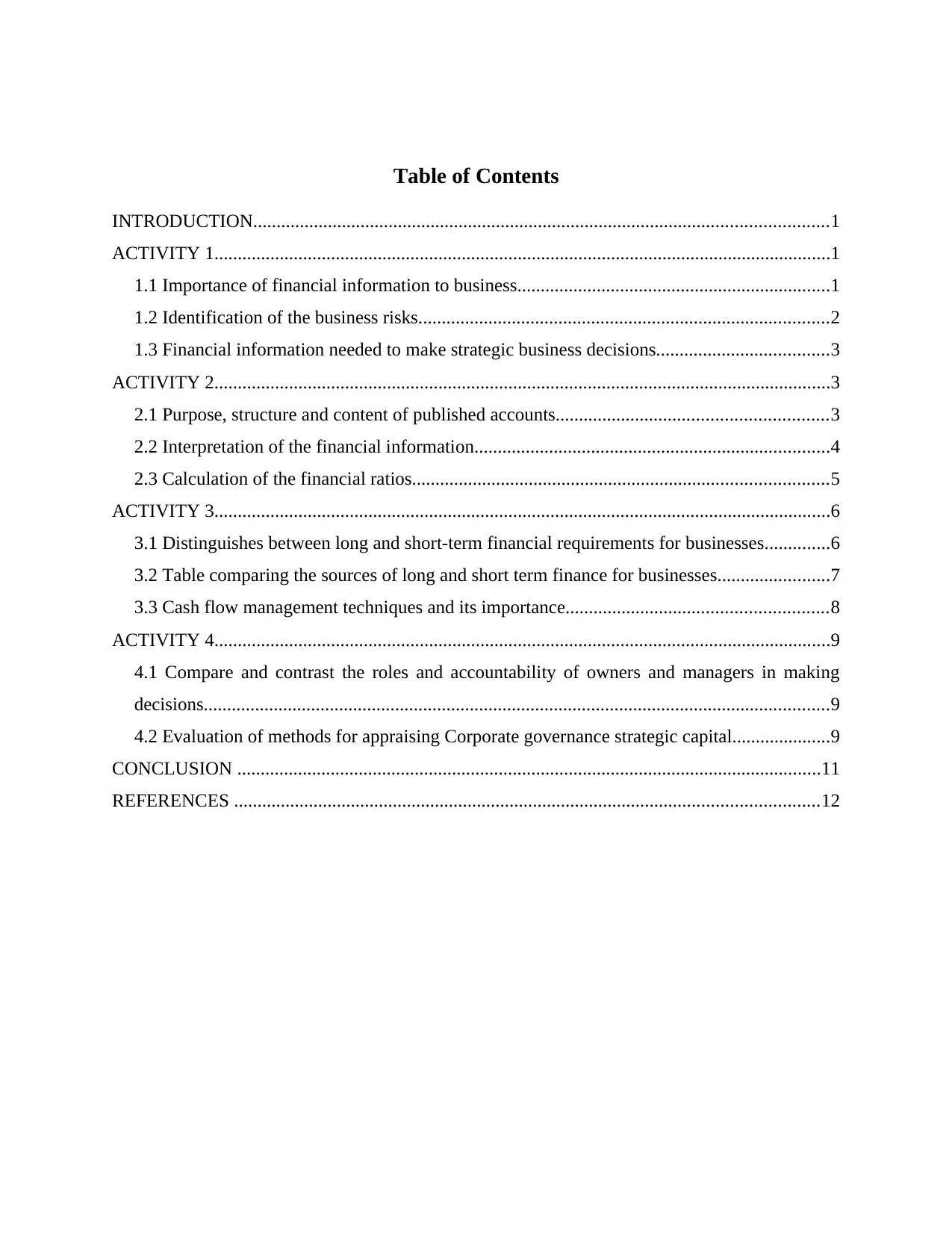
Table of Contents
INTRODUCTION...........................................................................................................................1
ACTIVITY 1....................................................................................................................................1
1.1 Importance of financial information to business...................................................................1
1.2 Identification of the business risks........................................................................................2
1.3 Financial information needed to make strategic business decisions.....................................3
ACTIVITY 2....................................................................................................................................3
2.1 Purpose, structure and content of published accounts..........................................................3
2.2 Interpretation of the financial information............................................................................4
2.3 Calculation of the financial ratios.........................................................................................5
ACTIVITY 3....................................................................................................................................6
3.1 Distinguishes between long and short-term financial requirements for businesses..............6
3.2 Table comparing the sources of long and short term finance for businesses........................7
3.3 Cash flow management techniques and its importance........................................................8
ACTIVITY 4....................................................................................................................................9
4.1 Compare and contrast the roles and accountability of owners and managers in making
decisions......................................................................................................................................9
4.2 Evaluation of methods for appraising Corporate governance strategic capital.....................9
CONCLUSION .............................................................................................................................11
REFERENCES .............................................................................................................................12
INTRODUCTION...........................................................................................................................1
ACTIVITY 1....................................................................................................................................1
1.1 Importance of financial information to business...................................................................1
1.2 Identification of the business risks........................................................................................2
1.3 Financial information needed to make strategic business decisions.....................................3
ACTIVITY 2....................................................................................................................................3
2.1 Purpose, structure and content of published accounts..........................................................3
2.2 Interpretation of the financial information............................................................................4
2.3 Calculation of the financial ratios.........................................................................................5
ACTIVITY 3....................................................................................................................................6
3.1 Distinguishes between long and short-term financial requirements for businesses..............6
3.2 Table comparing the sources of long and short term finance for businesses........................7
3.3 Cash flow management techniques and its importance........................................................8
ACTIVITY 4....................................................................................................................................9
4.1 Compare and contrast the roles and accountability of owners and managers in making
decisions......................................................................................................................................9
4.2 Evaluation of methods for appraising Corporate governance strategic capital.....................9
CONCLUSION .............................................................................................................................11
REFERENCES .............................................................................................................................12
⊘ This is a preview!⊘
Do you want full access?
Subscribe today to unlock all pages.

Trusted by 1+ million students worldwide
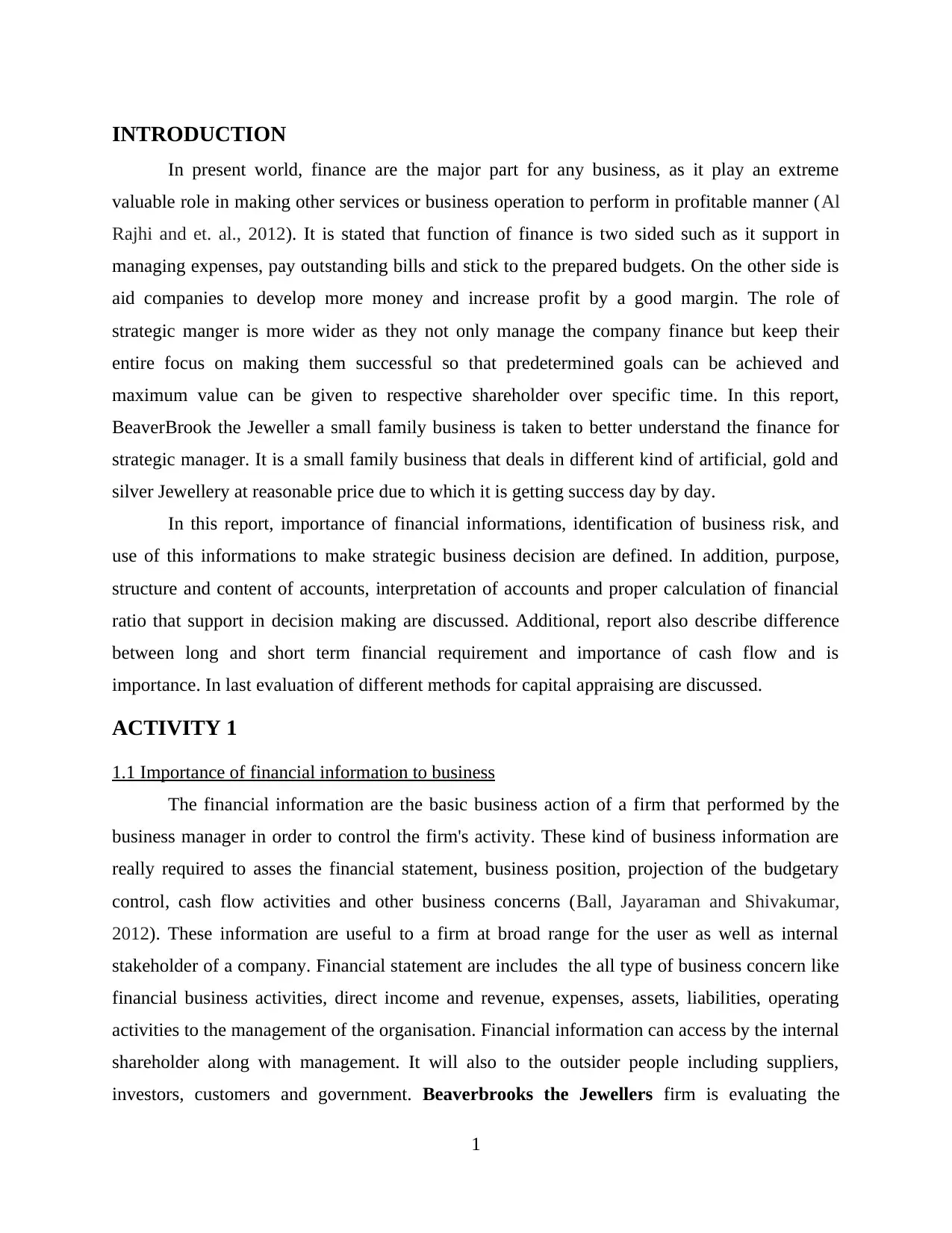
INTRODUCTION
In present world, finance are the major part for any business, as it play an extreme
valuable role in making other services or business operation to perform in profitable manner (Al
Rajhi and et. al., 2012). It is stated that function of finance is two sided such as it support in
managing expenses, pay outstanding bills and stick to the prepared budgets. On the other side is
aid companies to develop more money and increase profit by a good margin. The role of
strategic manger is more wider as they not only manage the company finance but keep their
entire focus on making them successful so that predetermined goals can be achieved and
maximum value can be given to respective shareholder over specific time. In this report,
BeaverBrook the Jeweller a small family business is taken to better understand the finance for
strategic manager. It is a small family business that deals in different kind of artificial, gold and
silver Jewellery at reasonable price due to which it is getting success day by day.
In this report, importance of financial informations, identification of business risk, and
use of this informations to make strategic business decision are defined. In addition, purpose,
structure and content of accounts, interpretation of accounts and proper calculation of financial
ratio that support in decision making are discussed. Additional, report also describe difference
between long and short term financial requirement and importance of cash flow and is
importance. In last evaluation of different methods for capital appraising are discussed.
ACTIVITY 1
1.1 Importance of financial information to business
The financial information are the basic business action of a firm that performed by the
business manager in order to control the firm's activity. These kind of business information are
really required to asses the financial statement, business position, projection of the budgetary
control, cash flow activities and other business concerns (Ball, Jayaraman and Shivakumar,
2012). These information are useful to a firm at broad range for the user as well as internal
stakeholder of a company. Financial statement are includes the all type of business concern like
financial business activities, direct income and revenue, expenses, assets, liabilities, operating
activities to the management of the organisation. Financial information can access by the internal
shareholder along with management. It will also to the outsider people including suppliers,
investors, customers and government. Beaverbrooks the Jewellers firm is evaluating the
1
In present world, finance are the major part for any business, as it play an extreme
valuable role in making other services or business operation to perform in profitable manner (Al
Rajhi and et. al., 2012). It is stated that function of finance is two sided such as it support in
managing expenses, pay outstanding bills and stick to the prepared budgets. On the other side is
aid companies to develop more money and increase profit by a good margin. The role of
strategic manger is more wider as they not only manage the company finance but keep their
entire focus on making them successful so that predetermined goals can be achieved and
maximum value can be given to respective shareholder over specific time. In this report,
BeaverBrook the Jeweller a small family business is taken to better understand the finance for
strategic manager. It is a small family business that deals in different kind of artificial, gold and
silver Jewellery at reasonable price due to which it is getting success day by day.
In this report, importance of financial informations, identification of business risk, and
use of this informations to make strategic business decision are defined. In addition, purpose,
structure and content of accounts, interpretation of accounts and proper calculation of financial
ratio that support in decision making are discussed. Additional, report also describe difference
between long and short term financial requirement and importance of cash flow and is
importance. In last evaluation of different methods for capital appraising are discussed.
ACTIVITY 1
1.1 Importance of financial information to business
The financial information are the basic business action of a firm that performed by the
business manager in order to control the firm's activity. These kind of business information are
really required to asses the financial statement, business position, projection of the budgetary
control, cash flow activities and other business concerns (Ball, Jayaraman and Shivakumar,
2012). These information are useful to a firm at broad range for the user as well as internal
stakeholder of a company. Financial statement are includes the all type of business concern like
financial business activities, direct income and revenue, expenses, assets, liabilities, operating
activities to the management of the organisation. Financial information can access by the internal
shareholder along with management. It will also to the outsider people including suppliers,
investors, customers and government. Beaverbrooks the Jewellers firm is evaluating the
1
Paraphrase This Document
Need a fresh take? Get an instant paraphrase of this document with our AI Paraphraser
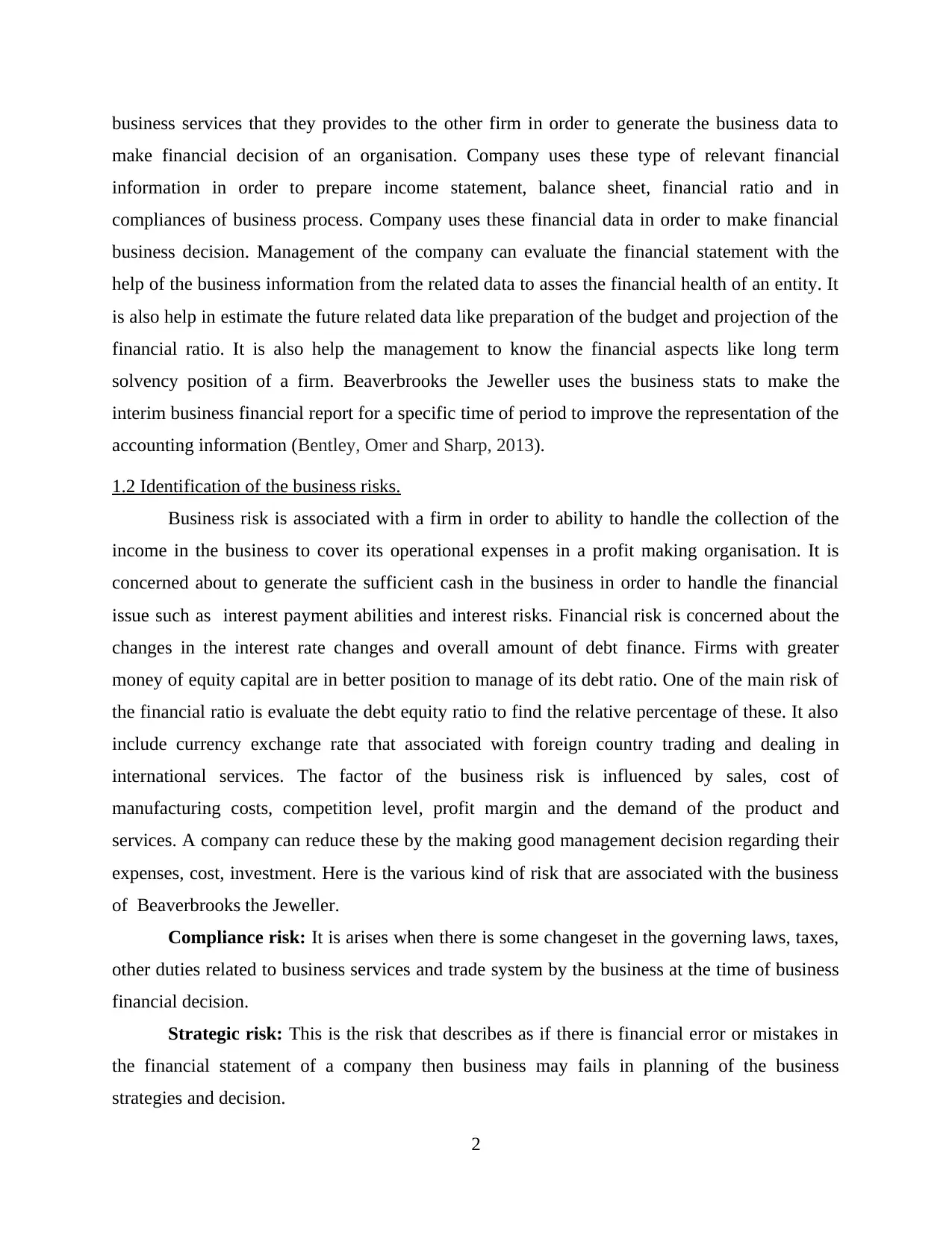
business services that they provides to the other firm in order to generate the business data to
make financial decision of an organisation. Company uses these type of relevant financial
information in order to prepare income statement, balance sheet, financial ratio and in
compliances of business process. Company uses these financial data in order to make financial
business decision. Management of the company can evaluate the financial statement with the
help of the business information from the related data to asses the financial health of an entity. It
is also help in estimate the future related data like preparation of the budget and projection of the
financial ratio. It is also help the management to know the financial aspects like long term
solvency position of a firm. Beaverbrooks the Jeweller uses the business stats to make the
interim business financial report for a specific time of period to improve the representation of the
accounting information (Bentley, Omer and Sharp, 2013).
1.2 Identification of the business risks.
Business risk is associated with a firm in order to ability to handle the collection of the
income in the business to cover its operational expenses in a profit making organisation. It is
concerned about to generate the sufficient cash in the business in order to handle the financial
issue such as interest payment abilities and interest risks. Financial risk is concerned about the
changes in the interest rate changes and overall amount of debt finance. Firms with greater
money of equity capital are in better position to manage of its debt ratio. One of the main risk of
the financial ratio is evaluate the debt equity ratio to find the relative percentage of these. It also
include currency exchange rate that associated with foreign country trading and dealing in
international services. The factor of the business risk is influenced by sales, cost of
manufacturing costs, competition level, profit margin and the demand of the product and
services. A company can reduce these by the making good management decision regarding their
expenses, cost, investment. Here is the various kind of risk that are associated with the business
of Beaverbrooks the Jeweller.
Compliance risk: It is arises when there is some changeset in the governing laws, taxes,
other duties related to business services and trade system by the business at the time of business
financial decision.
Strategic risk: This is the risk that describes as if there is financial error or mistakes in
the financial statement of a company then business may fails in planning of the business
strategies and decision.
2
make financial decision of an organisation. Company uses these type of relevant financial
information in order to prepare income statement, balance sheet, financial ratio and in
compliances of business process. Company uses these financial data in order to make financial
business decision. Management of the company can evaluate the financial statement with the
help of the business information from the related data to asses the financial health of an entity. It
is also help in estimate the future related data like preparation of the budget and projection of the
financial ratio. It is also help the management to know the financial aspects like long term
solvency position of a firm. Beaverbrooks the Jeweller uses the business stats to make the
interim business financial report for a specific time of period to improve the representation of the
accounting information (Bentley, Omer and Sharp, 2013).
1.2 Identification of the business risks.
Business risk is associated with a firm in order to ability to handle the collection of the
income in the business to cover its operational expenses in a profit making organisation. It is
concerned about to generate the sufficient cash in the business in order to handle the financial
issue such as interest payment abilities and interest risks. Financial risk is concerned about the
changes in the interest rate changes and overall amount of debt finance. Firms with greater
money of equity capital are in better position to manage of its debt ratio. One of the main risk of
the financial ratio is evaluate the debt equity ratio to find the relative percentage of these. It also
include currency exchange rate that associated with foreign country trading and dealing in
international services. The factor of the business risk is influenced by sales, cost of
manufacturing costs, competition level, profit margin and the demand of the product and
services. A company can reduce these by the making good management decision regarding their
expenses, cost, investment. Here is the various kind of risk that are associated with the business
of Beaverbrooks the Jeweller.
Compliance risk: It is arises when there is some changeset in the governing laws, taxes,
other duties related to business services and trade system by the business at the time of business
financial decision.
Strategic risk: This is the risk that describes as if there is financial error or mistakes in
the financial statement of a company then business may fails in planning of the business
strategies and decision.
2
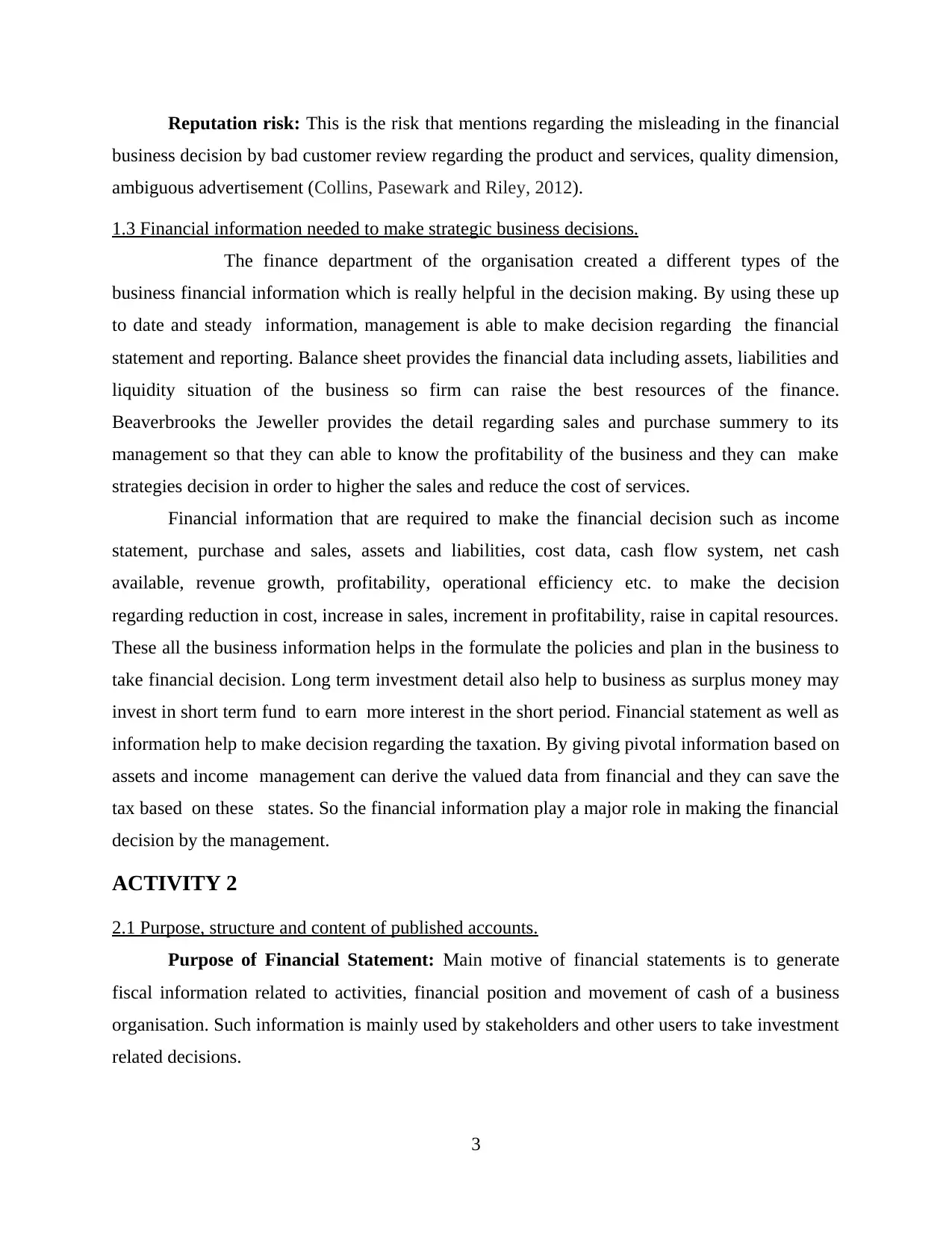
Reputation risk: This is the risk that mentions regarding the misleading in the financial
business decision by bad customer review regarding the product and services, quality dimension,
ambiguous advertisement (Collins, Pasewark and Riley, 2012).
1.3 Financial information needed to make strategic business decisions.
The finance department of the organisation created a different types of the
business financial information which is really helpful in the decision making. By using these up
to date and steady information, management is able to make decision regarding the financial
statement and reporting. Balance sheet provides the financial data including assets, liabilities and
liquidity situation of the business so firm can raise the best resources of the finance.
Beaverbrooks the Jeweller provides the detail regarding sales and purchase summery to its
management so that they can able to know the profitability of the business and they can make
strategies decision in order to higher the sales and reduce the cost of services.
Financial information that are required to make the financial decision such as income
statement, purchase and sales, assets and liabilities, cost data, cash flow system, net cash
available, revenue growth, profitability, operational efficiency etc. to make the decision
regarding reduction in cost, increase in sales, increment in profitability, raise in capital resources.
These all the business information helps in the formulate the policies and plan in the business to
take financial decision. Long term investment detail also help to business as surplus money may
invest in short term fund to earn more interest in the short period. Financial statement as well as
information help to make decision regarding the taxation. By giving pivotal information based on
assets and income management can derive the valued data from financial and they can save the
tax based on these states. So the financial information play a major role in making the financial
decision by the management.
ACTIVITY 2
2.1 Purpose, structure and content of published accounts.
Purpose of Financial Statement: Main motive of financial statements is to generate
fiscal information related to activities, financial position and movement of cash of a business
organisation. Such information is mainly used by stakeholders and other users to take investment
related decisions.
3
business decision by bad customer review regarding the product and services, quality dimension,
ambiguous advertisement (Collins, Pasewark and Riley, 2012).
1.3 Financial information needed to make strategic business decisions.
The finance department of the organisation created a different types of the
business financial information which is really helpful in the decision making. By using these up
to date and steady information, management is able to make decision regarding the financial
statement and reporting. Balance sheet provides the financial data including assets, liabilities and
liquidity situation of the business so firm can raise the best resources of the finance.
Beaverbrooks the Jeweller provides the detail regarding sales and purchase summery to its
management so that they can able to know the profitability of the business and they can make
strategies decision in order to higher the sales and reduce the cost of services.
Financial information that are required to make the financial decision such as income
statement, purchase and sales, assets and liabilities, cost data, cash flow system, net cash
available, revenue growth, profitability, operational efficiency etc. to make the decision
regarding reduction in cost, increase in sales, increment in profitability, raise in capital resources.
These all the business information helps in the formulate the policies and plan in the business to
take financial decision. Long term investment detail also help to business as surplus money may
invest in short term fund to earn more interest in the short period. Financial statement as well as
information help to make decision regarding the taxation. By giving pivotal information based on
assets and income management can derive the valued data from financial and they can save the
tax based on these states. So the financial information play a major role in making the financial
decision by the management.
ACTIVITY 2
2.1 Purpose, structure and content of published accounts.
Purpose of Financial Statement: Main motive of financial statements is to generate
fiscal information related to activities, financial position and movement of cash of a business
organisation. Such information is mainly used by stakeholders and other users to take investment
related decisions.
3
⊘ This is a preview!⊘
Do you want full access?
Subscribe today to unlock all pages.

Trusted by 1+ million students worldwide
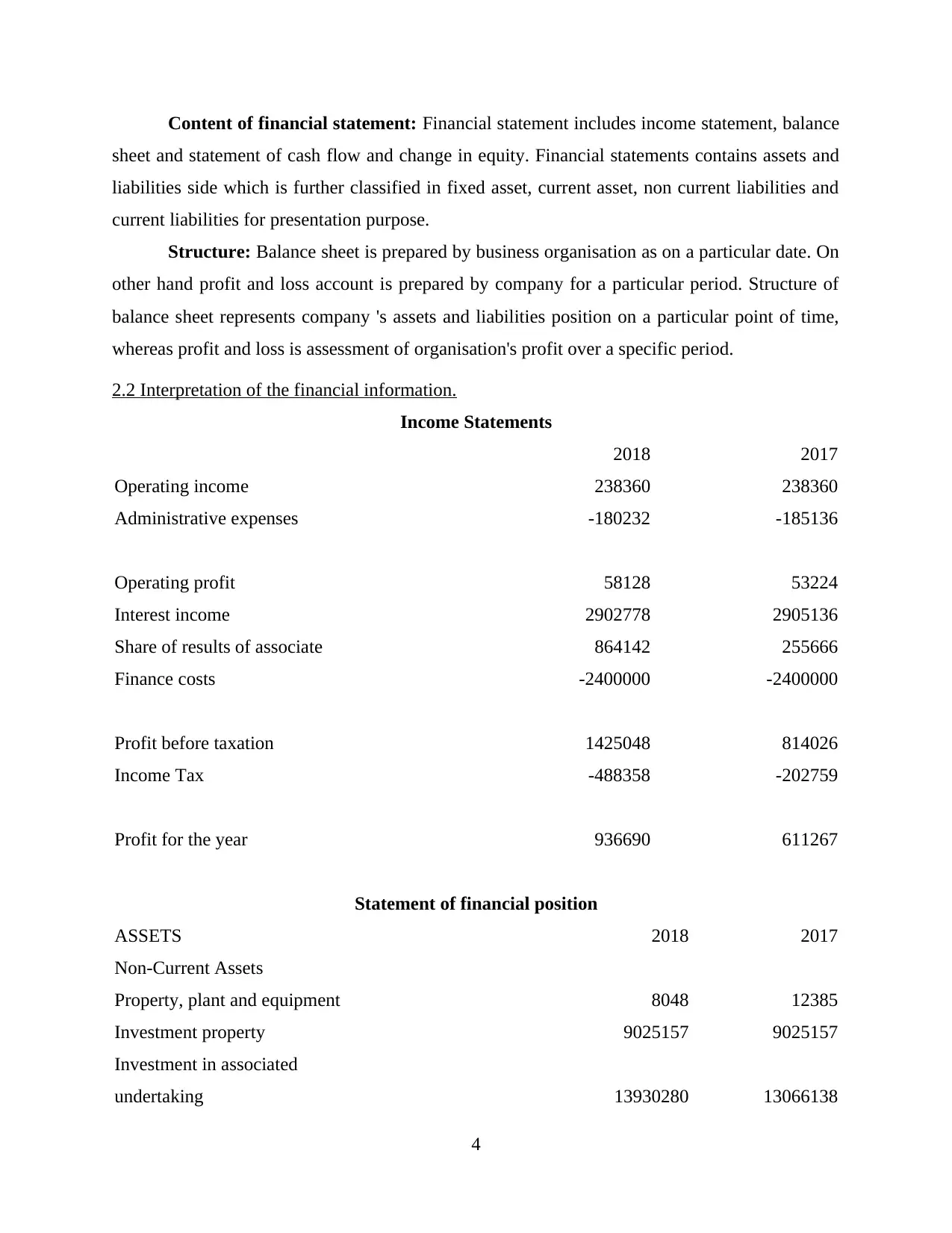
Content of financial statement: Financial statement includes income statement, balance
sheet and statement of cash flow and change in equity. Financial statements contains assets and
liabilities side which is further classified in fixed asset, current asset, non current liabilities and
current liabilities for presentation purpose.
Structure: Balance sheet is prepared by business organisation as on a particular date. On
other hand profit and loss account is prepared by company for a particular period. Structure of
balance sheet represents company 's assets and liabilities position on a particular point of time,
whereas profit and loss is assessment of organisation's profit over a specific period.
2.2 Interpretation of the financial information.
Income Statements
2018 2017
Operating income 238360 238360
Administrative expenses -180232 -185136
Operating profit 58128 53224
Interest income 2902778 2905136
Share of results of associate 864142 255666
Finance costs -2400000 -2400000
Profit before taxation 1425048 814026
Income Tax -488358 -202759
Profit for the year 936690 611267
Statement of financial position
ASSETS 2018 2017
Non-Current Assets
Property, plant and equipment 8048 12385
Investment property 9025157 9025157
Investment in associated
undertaking 13930280 13066138
4
sheet and statement of cash flow and change in equity. Financial statements contains assets and
liabilities side which is further classified in fixed asset, current asset, non current liabilities and
current liabilities for presentation purpose.
Structure: Balance sheet is prepared by business organisation as on a particular date. On
other hand profit and loss account is prepared by company for a particular period. Structure of
balance sheet represents company 's assets and liabilities position on a particular point of time,
whereas profit and loss is assessment of organisation's profit over a specific period.
2.2 Interpretation of the financial information.
Income Statements
2018 2017
Operating income 238360 238360
Administrative expenses -180232 -185136
Operating profit 58128 53224
Interest income 2902778 2905136
Share of results of associate 864142 255666
Finance costs -2400000 -2400000
Profit before taxation 1425048 814026
Income Tax -488358 -202759
Profit for the year 936690 611267
Statement of financial position
ASSETS 2018 2017
Non-Current Assets
Property, plant and equipment 8048 12385
Investment property 9025157 9025157
Investment in associated
undertaking 13930280 13066138
4
Paraphrase This Document
Need a fresh take? Get an instant paraphrase of this document with our AI Paraphraser
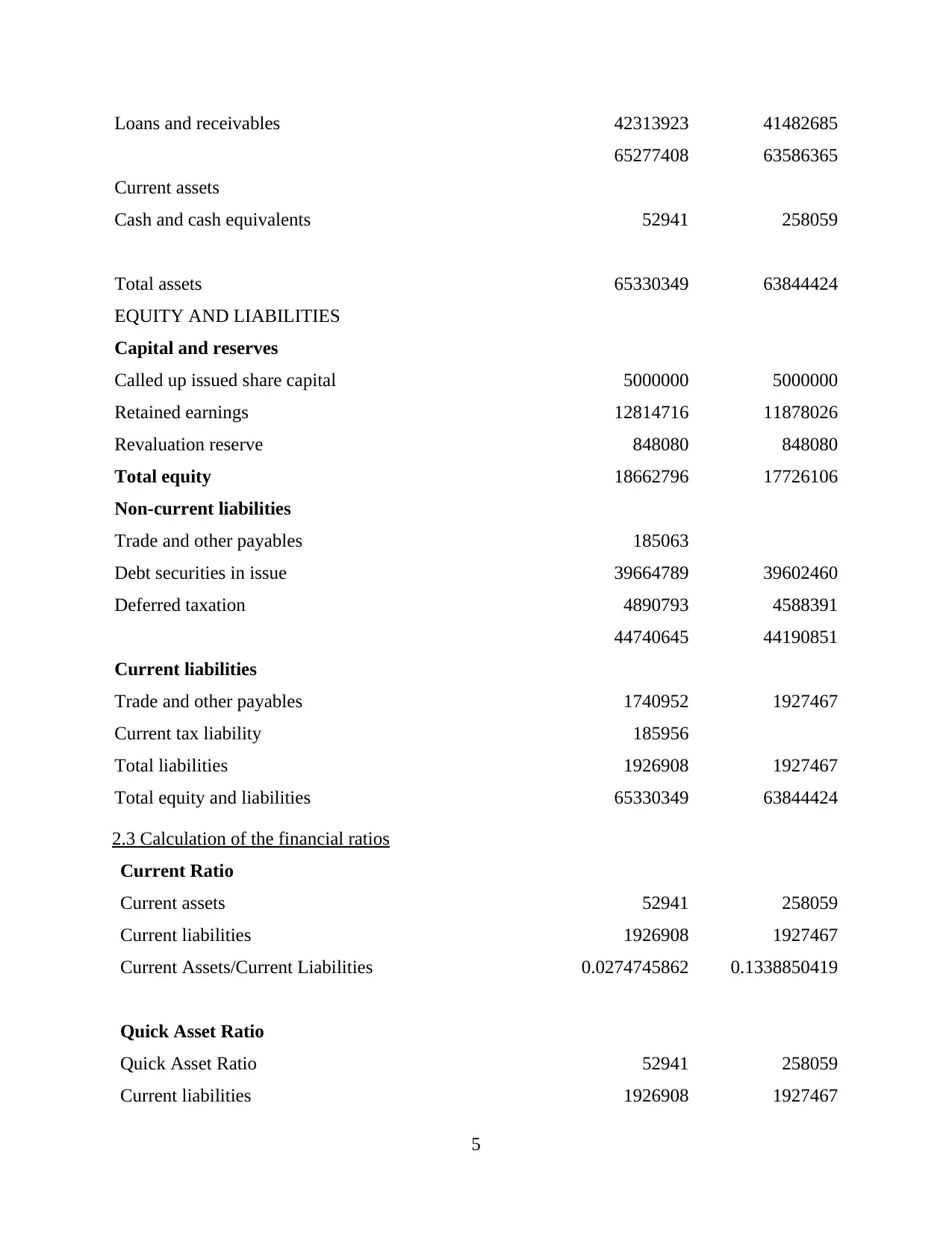
Loans and receivables 42313923 41482685
65277408 63586365
Current assets
Cash and cash equivalents 52941 258059
Total assets 65330349 63844424
EQUITY AND LIABILITIES
Capital and reserves
Called up issued share capital 5000000 5000000
Retained earnings 12814716 11878026
Revaluation reserve 848080 848080
Total equity 18662796 17726106
Non-current liabilities
Trade and other payables 185063
Debt securities in issue 39664789 39602460
Deferred taxation 4890793 4588391
44740645 44190851
Current liabilities
Trade and other payables 1740952 1927467
Current tax liability 185956
Total liabilities 1926908 1927467
Total equity and liabilities 65330349 63844424
2.3 Calculation of the financial ratios
Current Ratio
Current assets 52941 258059
Current liabilities 1926908 1927467
Current Assets/Current Liabilities 0.0274745862 0.1338850419
Quick Asset Ratio
Quick Asset Ratio 52941 258059
Current liabilities 1926908 1927467
5
65277408 63586365
Current assets
Cash and cash equivalents 52941 258059
Total assets 65330349 63844424
EQUITY AND LIABILITIES
Capital and reserves
Called up issued share capital 5000000 5000000
Retained earnings 12814716 11878026
Revaluation reserve 848080 848080
Total equity 18662796 17726106
Non-current liabilities
Trade and other payables 185063
Debt securities in issue 39664789 39602460
Deferred taxation 4890793 4588391
44740645 44190851
Current liabilities
Trade and other payables 1740952 1927467
Current tax liability 185956
Total liabilities 1926908 1927467
Total equity and liabilities 65330349 63844424
2.3 Calculation of the financial ratios
Current Ratio
Current assets 52941 258059
Current liabilities 1926908 1927467
Current Assets/Current Liabilities 0.0274745862 0.1338850419
Quick Asset Ratio
Quick Asset Ratio 52941 258059
Current liabilities 1926908 1927467
5
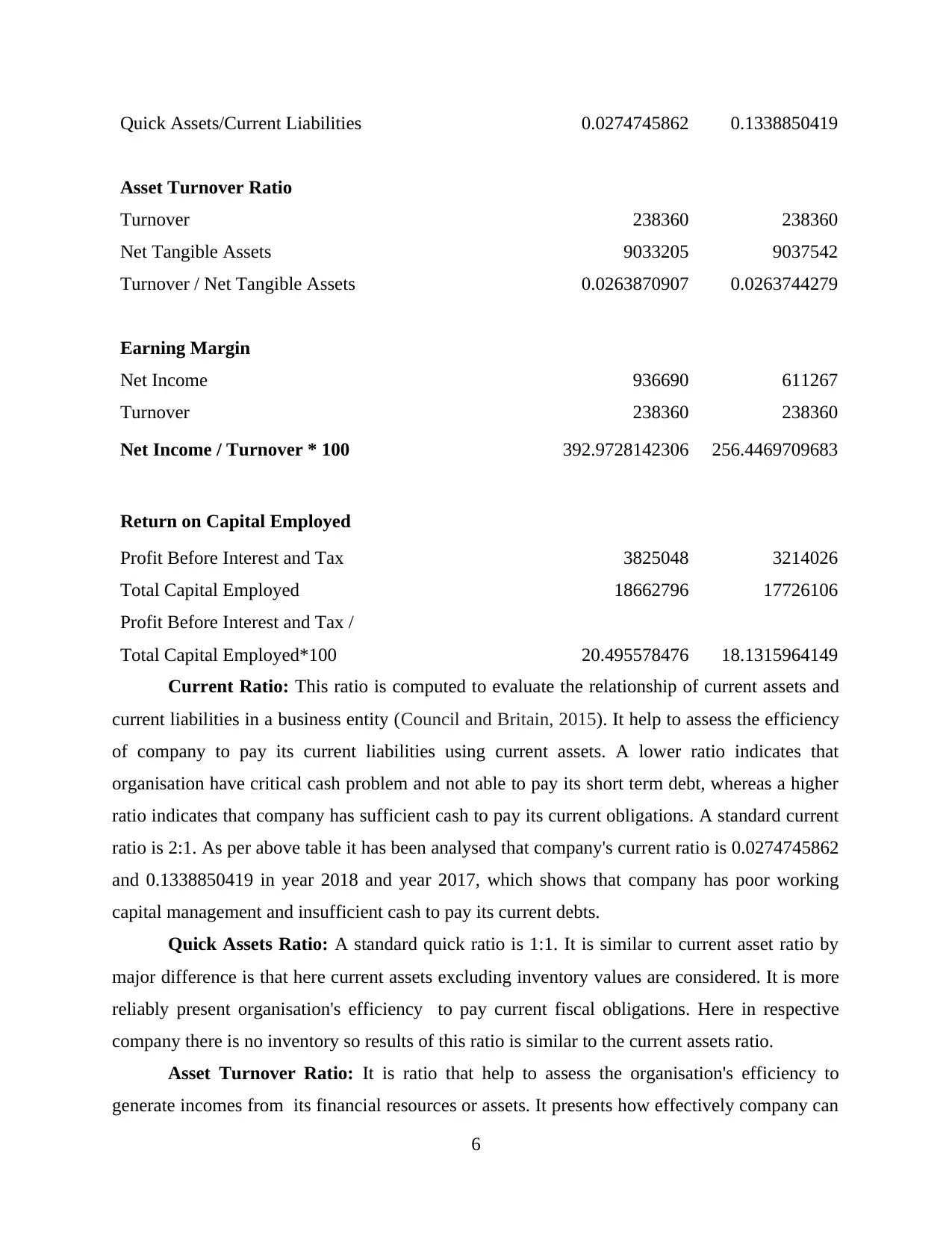
Quick Assets/Current Liabilities 0.0274745862 0.1338850419
Asset Turnover Ratio
Turnover 238360 238360
Net Tangible Assets 9033205 9037542
Turnover / Net Tangible Assets 0.0263870907 0.0263744279
Earning Margin
Net Income 936690 611267
Turnover 238360 238360
Net Income / Turnover * 100 392.9728142306 256.4469709683
Return on Capital Employed
Profit Before Interest and Tax 3825048 3214026
Total Capital Employed 18662796 17726106
Profit Before Interest and Tax /
Total Capital Employed*100 20.495578476 18.1315964149
Current Ratio: This ratio is computed to evaluate the relationship of current assets and
current liabilities in a business entity (Council and Britain, 2015). It help to assess the efficiency
of company to pay its current liabilities using current assets. A lower ratio indicates that
organisation have critical cash problem and not able to pay its short term debt, whereas a higher
ratio indicates that company has sufficient cash to pay its current obligations. A standard current
ratio is 2:1. As per above table it has been analysed that company's current ratio is 0.0274745862
and 0.1338850419 in year 2018 and year 2017, which shows that company has poor working
capital management and insufficient cash to pay its current debts.
Quick Assets Ratio: A standard quick ratio is 1:1. It is similar to current asset ratio by
major difference is that here current assets excluding inventory values are considered. It is more
reliably present organisation's efficiency to pay current fiscal obligations. Here in respective
company there is no inventory so results of this ratio is similar to the current assets ratio.
Asset Turnover Ratio: It is ratio that help to assess the organisation's efficiency to
generate incomes from its financial resources or assets. It presents how effectively company can
6
Asset Turnover Ratio
Turnover 238360 238360
Net Tangible Assets 9033205 9037542
Turnover / Net Tangible Assets 0.0263870907 0.0263744279
Earning Margin
Net Income 936690 611267
Turnover 238360 238360
Net Income / Turnover * 100 392.9728142306 256.4469709683
Return on Capital Employed
Profit Before Interest and Tax 3825048 3214026
Total Capital Employed 18662796 17726106
Profit Before Interest and Tax /
Total Capital Employed*100 20.495578476 18.1315964149
Current Ratio: This ratio is computed to evaluate the relationship of current assets and
current liabilities in a business entity (Council and Britain, 2015). It help to assess the efficiency
of company to pay its current liabilities using current assets. A lower ratio indicates that
organisation have critical cash problem and not able to pay its short term debt, whereas a higher
ratio indicates that company has sufficient cash to pay its current obligations. A standard current
ratio is 2:1. As per above table it has been analysed that company's current ratio is 0.0274745862
and 0.1338850419 in year 2018 and year 2017, which shows that company has poor working
capital management and insufficient cash to pay its current debts.
Quick Assets Ratio: A standard quick ratio is 1:1. It is similar to current asset ratio by
major difference is that here current assets excluding inventory values are considered. It is more
reliably present organisation's efficiency to pay current fiscal obligations. Here in respective
company there is no inventory so results of this ratio is similar to the current assets ratio.
Asset Turnover Ratio: It is ratio that help to assess the organisation's efficiency to
generate incomes from its financial resources or assets. It presents how effectively company can
6
⊘ This is a preview!⊘
Do you want full access?
Subscribe today to unlock all pages.

Trusted by 1+ million students worldwide
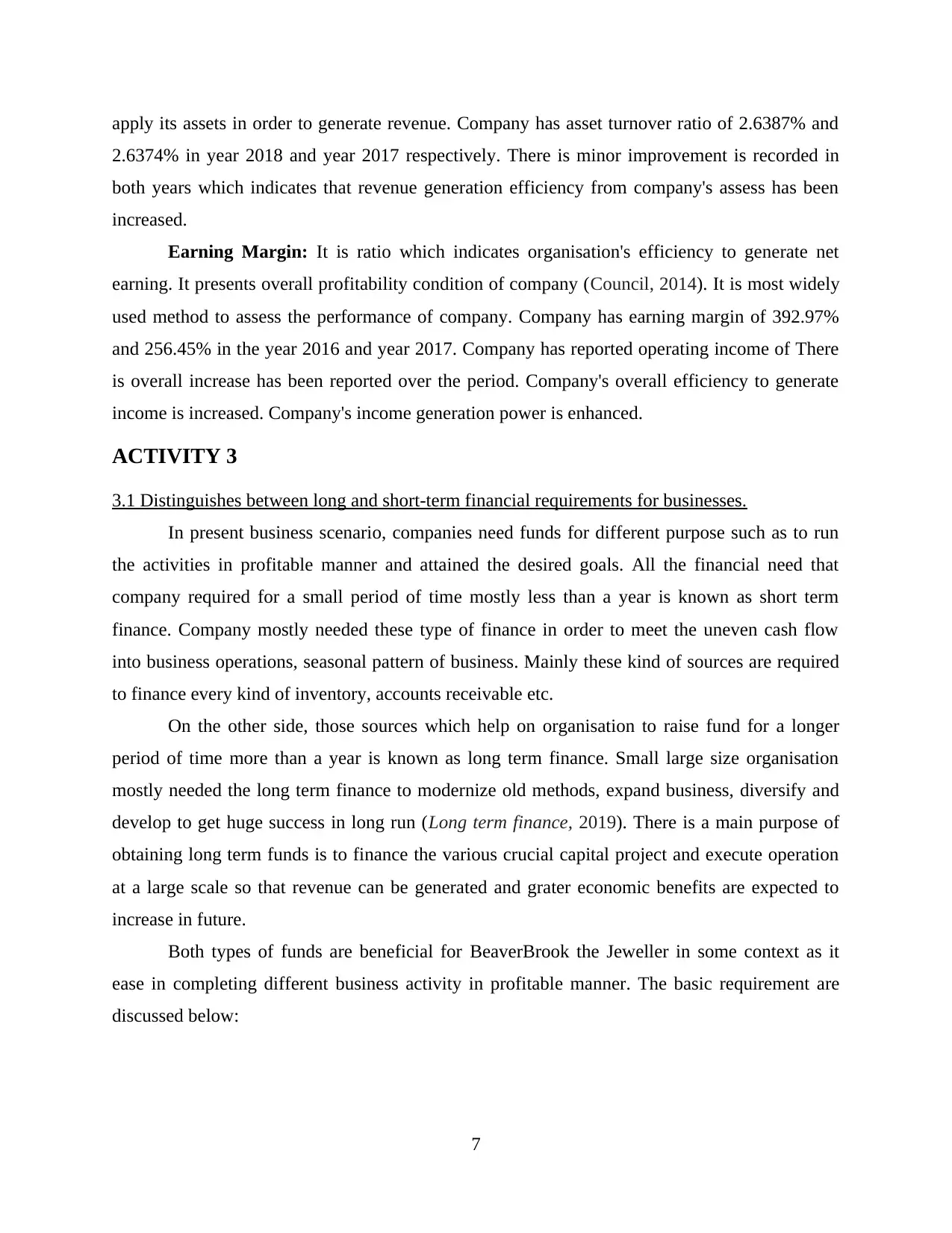
apply its assets in order to generate revenue. Company has asset turnover ratio of 2.6387% and
2.6374% in year 2018 and year 2017 respectively. There is minor improvement is recorded in
both years which indicates that revenue generation efficiency from company's assess has been
increased.
Earning Margin: It is ratio which indicates organisation's efficiency to generate net
earning. It presents overall profitability condition of company (Council, 2014). It is most widely
used method to assess the performance of company. Company has earning margin of 392.97%
and 256.45% in the year 2016 and year 2017. Company has reported operating income of There
is overall increase has been reported over the period. Company's overall efficiency to generate
income is increased. Company's income generation power is enhanced.
ACTIVITY 3
3.1 Distinguishes between long and short-term financial requirements for businesses.
In present business scenario, companies need funds for different purpose such as to run
the activities in profitable manner and attained the desired goals. All the financial need that
company required for a small period of time mostly less than a year is known as short term
finance. Company mostly needed these type of finance in order to meet the uneven cash flow
into business operations, seasonal pattern of business. Mainly these kind of sources are required
to finance every kind of inventory, accounts receivable etc.
On the other side, those sources which help on organisation to raise fund for a longer
period of time more than a year is known as long term finance. Small large size organisation
mostly needed the long term finance to modernize old methods, expand business, diversify and
develop to get huge success in long run (Long term finance, 2019). There is a main purpose of
obtaining long term funds is to finance the various crucial capital project and execute operation
at a large scale so that revenue can be generated and grater economic benefits are expected to
increase in future.
Both types of funds are beneficial for BeaverBrook the Jeweller in some context as it
ease in completing different business activity in profitable manner. The basic requirement are
discussed below:
7
2.6374% in year 2018 and year 2017 respectively. There is minor improvement is recorded in
both years which indicates that revenue generation efficiency from company's assess has been
increased.
Earning Margin: It is ratio which indicates organisation's efficiency to generate net
earning. It presents overall profitability condition of company (Council, 2014). It is most widely
used method to assess the performance of company. Company has earning margin of 392.97%
and 256.45% in the year 2016 and year 2017. Company has reported operating income of There
is overall increase has been reported over the period. Company's overall efficiency to generate
income is increased. Company's income generation power is enhanced.
ACTIVITY 3
3.1 Distinguishes between long and short-term financial requirements for businesses.
In present business scenario, companies need funds for different purpose such as to run
the activities in profitable manner and attained the desired goals. All the financial need that
company required for a small period of time mostly less than a year is known as short term
finance. Company mostly needed these type of finance in order to meet the uneven cash flow
into business operations, seasonal pattern of business. Mainly these kind of sources are required
to finance every kind of inventory, accounts receivable etc.
On the other side, those sources which help on organisation to raise fund for a longer
period of time more than a year is known as long term finance. Small large size organisation
mostly needed the long term finance to modernize old methods, expand business, diversify and
develop to get huge success in long run (Long term finance, 2019). There is a main purpose of
obtaining long term funds is to finance the various crucial capital project and execute operation
at a large scale so that revenue can be generated and grater economic benefits are expected to
increase in future.
Both types of funds are beneficial for BeaverBrook the Jeweller in some context as it
ease in completing different business activity in profitable manner. The basic requirement are
discussed below:
7
Paraphrase This Document
Need a fresh take? Get an instant paraphrase of this document with our AI Paraphraser
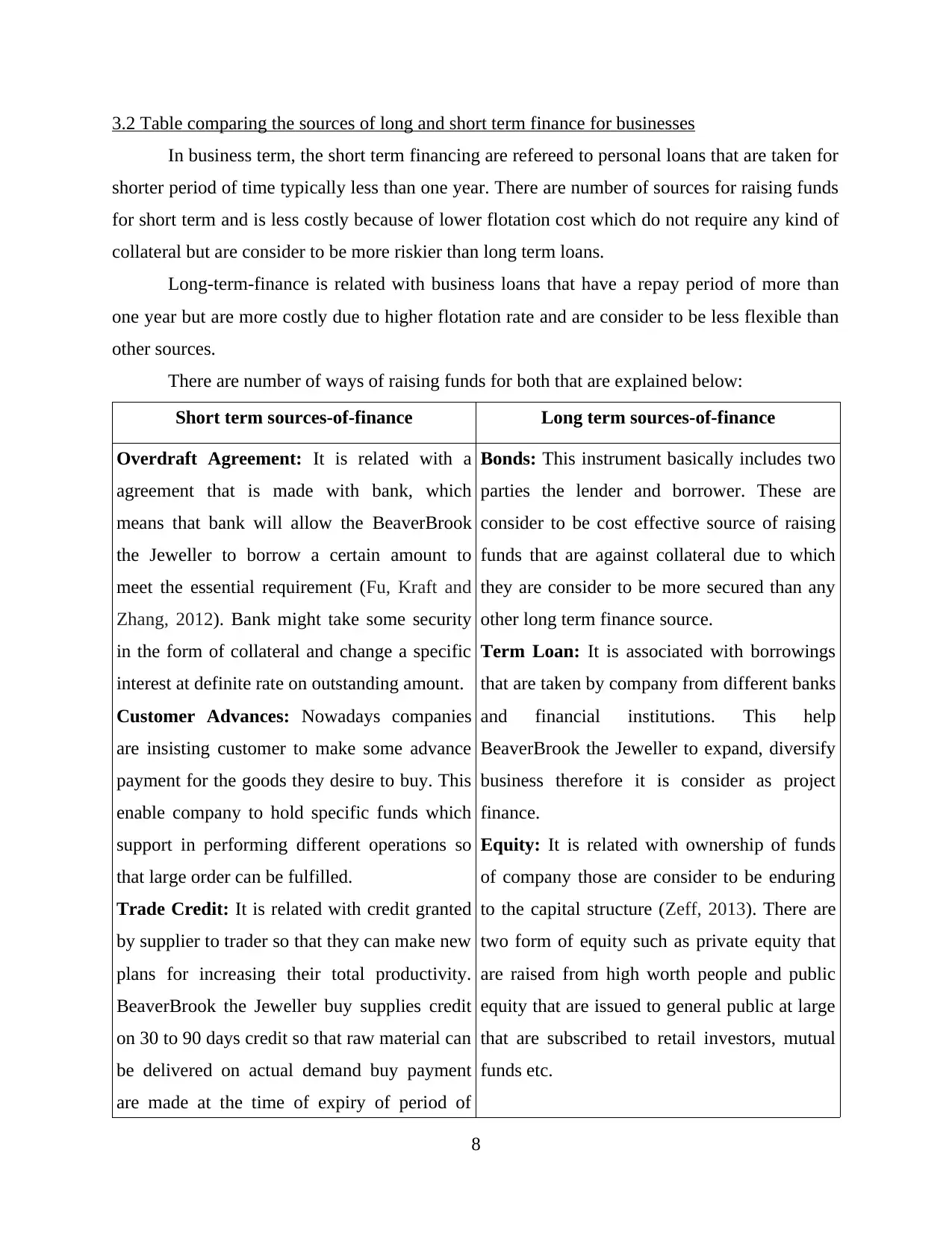
3.2 Table comparing the sources of long and short term finance for businesses
In business term, the short term financing are refereed to personal loans that are taken for
shorter period of time typically less than one year. There are number of sources for raising funds
for short term and is less costly because of lower flotation cost which do not require any kind of
collateral but are consider to be more riskier than long term loans.
Long-term-finance is related with business loans that have a repay period of more than
one year but are more costly due to higher flotation rate and are consider to be less flexible than
other sources.
There are number of ways of raising funds for both that are explained below:
Short term sources-of-finance Long term sources-of-finance
Overdraft Agreement: It is related with a
agreement that is made with bank, which
means that bank will allow the BeaverBrook
the Jeweller to borrow a certain amount to
meet the essential requirement (Fu, Kraft and
Zhang, 2012). Bank might take some security
in the form of collateral and change a specific
interest at definite rate on outstanding amount.
Customer Advances: Nowadays companies
are insisting customer to make some advance
payment for the goods they desire to buy. This
enable company to hold specific funds which
support in performing different operations so
that large order can be fulfilled.
Trade Credit: It is related with credit granted
by supplier to trader so that they can make new
plans for increasing their total productivity.
BeaverBrook the Jeweller buy supplies credit
on 30 to 90 days credit so that raw material can
be delivered on actual demand buy payment
are made at the time of expiry of period of
Bonds: This instrument basically includes two
parties the lender and borrower. These are
consider to be cost effective source of raising
funds that are against collateral due to which
they are consider to be more secured than any
other long term finance source.
Term Loan: It is associated with borrowings
that are taken by company from different banks
and financial institutions. This help
BeaverBrook the Jeweller to expand, diversify
business therefore it is consider as project
finance.
Equity: It is related with ownership of funds
of company those are consider to be enduring
to the capital structure (Zeff, 2013). There are
two form of equity such as private equity that
are raised from high worth people and public
equity that are issued to general public at large
that are subscribed to retail investors, mutual
funds etc.
8
In business term, the short term financing are refereed to personal loans that are taken for
shorter period of time typically less than one year. There are number of sources for raising funds
for short term and is less costly because of lower flotation cost which do not require any kind of
collateral but are consider to be more riskier than long term loans.
Long-term-finance is related with business loans that have a repay period of more than
one year but are more costly due to higher flotation rate and are consider to be less flexible than
other sources.
There are number of ways of raising funds for both that are explained below:
Short term sources-of-finance Long term sources-of-finance
Overdraft Agreement: It is related with a
agreement that is made with bank, which
means that bank will allow the BeaverBrook
the Jeweller to borrow a certain amount to
meet the essential requirement (Fu, Kraft and
Zhang, 2012). Bank might take some security
in the form of collateral and change a specific
interest at definite rate on outstanding amount.
Customer Advances: Nowadays companies
are insisting customer to make some advance
payment for the goods they desire to buy. This
enable company to hold specific funds which
support in performing different operations so
that large order can be fulfilled.
Trade Credit: It is related with credit granted
by supplier to trader so that they can make new
plans for increasing their total productivity.
BeaverBrook the Jeweller buy supplies credit
on 30 to 90 days credit so that raw material can
be delivered on actual demand buy payment
are made at the time of expiry of period of
Bonds: This instrument basically includes two
parties the lender and borrower. These are
consider to be cost effective source of raising
funds that are against collateral due to which
they are consider to be more secured than any
other long term finance source.
Term Loan: It is associated with borrowings
that are taken by company from different banks
and financial institutions. This help
BeaverBrook the Jeweller to expand, diversify
business therefore it is consider as project
finance.
Equity: It is related with ownership of funds
of company those are consider to be enduring
to the capital structure (Zeff, 2013). There are
two form of equity such as private equity that
are raised from high worth people and public
equity that are issued to general public at large
that are subscribed to retail investors, mutual
funds etc.
8
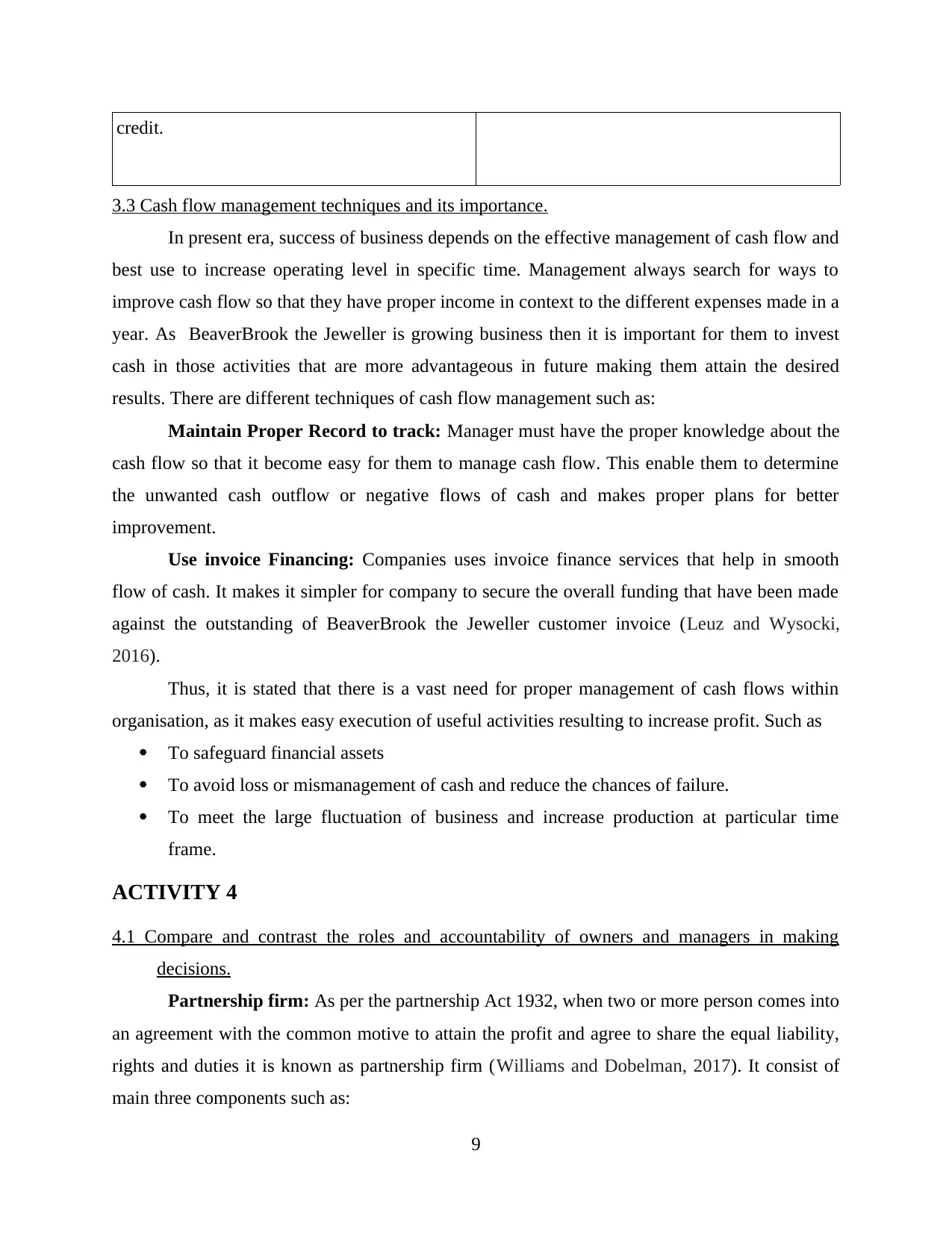
credit.
3.3 Cash flow management techniques and its importance.
In present era, success of business depends on the effective management of cash flow and
best use to increase operating level in specific time. Management always search for ways to
improve cash flow so that they have proper income in context to the different expenses made in a
year. As BeaverBrook the Jeweller is growing business then it is important for them to invest
cash in those activities that are more advantageous in future making them attain the desired
results. There are different techniques of cash flow management such as:
Maintain Proper Record to track: Manager must have the proper knowledge about the
cash flow so that it become easy for them to manage cash flow. This enable them to determine
the unwanted cash outflow or negative flows of cash and makes proper plans for better
improvement.
Use invoice Financing: Companies uses invoice finance services that help in smooth
flow of cash. It makes it simpler for company to secure the overall funding that have been made
against the outstanding of BeaverBrook the Jeweller customer invoice (Leuz and Wysocki,
2016).
Thus, it is stated that there is a vast need for proper management of cash flows within
organisation, as it makes easy execution of useful activities resulting to increase profit. Such as
To safeguard financial assets
To avoid loss or mismanagement of cash and reduce the chances of failure.
To meet the large fluctuation of business and increase production at particular time
frame.
ACTIVITY 4
4.1 Compare and contrast the roles and accountability of owners and managers in making
decisions.
Partnership firm: As per the partnership Act 1932, when two or more person comes into
an agreement with the common motive to attain the profit and agree to share the equal liability,
rights and duties it is known as partnership firm (Williams and Dobelman, 2017). It consist of
main three components such as:
9
3.3 Cash flow management techniques and its importance.
In present era, success of business depends on the effective management of cash flow and
best use to increase operating level in specific time. Management always search for ways to
improve cash flow so that they have proper income in context to the different expenses made in a
year. As BeaverBrook the Jeweller is growing business then it is important for them to invest
cash in those activities that are more advantageous in future making them attain the desired
results. There are different techniques of cash flow management such as:
Maintain Proper Record to track: Manager must have the proper knowledge about the
cash flow so that it become easy for them to manage cash flow. This enable them to determine
the unwanted cash outflow or negative flows of cash and makes proper plans for better
improvement.
Use invoice Financing: Companies uses invoice finance services that help in smooth
flow of cash. It makes it simpler for company to secure the overall funding that have been made
against the outstanding of BeaverBrook the Jeweller customer invoice (Leuz and Wysocki,
2016).
Thus, it is stated that there is a vast need for proper management of cash flows within
organisation, as it makes easy execution of useful activities resulting to increase profit. Such as
To safeguard financial assets
To avoid loss or mismanagement of cash and reduce the chances of failure.
To meet the large fluctuation of business and increase production at particular time
frame.
ACTIVITY 4
4.1 Compare and contrast the roles and accountability of owners and managers in making
decisions.
Partnership firm: As per the partnership Act 1932, when two or more person comes into
an agreement with the common motive to attain the profit and agree to share the equal liability,
rights and duties it is known as partnership firm (Williams and Dobelman, 2017). It consist of
main three components such as:
9
⊘ This is a preview!⊘
Do you want full access?
Subscribe today to unlock all pages.

Trusted by 1+ million students worldwide
1 out of 15
Related Documents
Your All-in-One AI-Powered Toolkit for Academic Success.
+13062052269
info@desklib.com
Available 24*7 on WhatsApp / Email
![[object Object]](/_next/static/media/star-bottom.7253800d.svg)
Unlock your academic potential
Copyright © 2020–2025 A2Z Services. All Rights Reserved. Developed and managed by ZUCOL.





